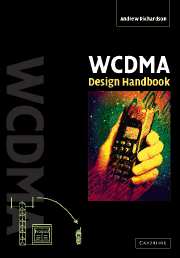Book contents
- Frontmatter
- Dedication
- Contents
- Preface
- Acknowledgements
- List of abbreviations
- 1 Introduction
- 2 WCDMA in a nutshell
- 3 Spreading codes and modulation
- 4 Physical layer
- 5 RF aspects
- 6 Chip rate processing functions
- 7 Symbol rate processing functions
- 8 Layer 2 - medium access control (MAC)
- 9 Layer 2 - RLC
- 10 PDCP and BMC protocols
- 11 Layer 3 - RRC
- 12 Measurements
- 13 NAS
- 14 Idle mode functions
- Appendix
- References
- Index
7 - Symbol rate processing functions
Published online by Cambridge University Press: 05 October 2013
- Frontmatter
- Dedication
- Contents
- Preface
- Acknowledgements
- List of abbreviations
- 1 Introduction
- 2 WCDMA in a nutshell
- 3 Spreading codes and modulation
- 4 Physical layer
- 5 RF aspects
- 6 Chip rate processing functions
- 7 Symbol rate processing functions
- 8 Layer 2 - medium access control (MAC)
- 9 Layer 2 - RLC
- 10 PDCP and BMC protocols
- 11 Layer 3 - RRC
- 12 Measurements
- 13 NAS
- 14 Idle mode functions
- Appendix
- References
- Index
Summary
WCDMA symbol rate transmission path
In this chapter we review the basic principles of what we call the symbol rate processing functions, but are also often referred to as bit rate processing functions. These functions apply to both transmit and receive paths of the WCDMA system. Additionally, we explore functions such as error protection coding, rate matching and the topic of transport channel combination. We start with a review of the uplink/downlink symbol rate transmission path (this is the same for the downlink/uplink receive path, but traversed in the reverse direction). Then we review some of the basic principles of convolutional error correcting codes, and finally we finish with an exploration of turbo codes, the turbo decoder and in particular the maximum a-posteriori probability (MAP) algorithm.
Coding introduction
Figure 7.1 presents the basic structure of the lower layers of the transmission link between the UE and the UTRAN. The diagram is a simplification of the processing stages that are considered in greater detail shortly. The diagram illustrates the basic principles in the operation of the symbol rate processing stages within the WCDMA system. Data are received via transport channels from the MAC. The data blocks may have cyclic redundancy check (CRC) bits appended for error detection purposes in the receiver. The data are then encoded using either a convolutional encoder or a turbo encoder. Next, interleaving is performed to ‘shuffle’ the data prior to transmission to help combat fading and interference across the radio link.
- Type
- Chapter
- Information
- WCDMA Design Handbook , pp. 217 - 247Publisher: Cambridge University PressPrint publication year: 2005



